Article contents
Alexander of Aphrodisias on Vision in the Atomists
Published online by Cambridge University Press: 11 February 2009
Extract
In discussing the atomists' theory of vision modern accounts have quite neglected to take into account two sections of Alexander of Aphrodisias on this topic. Nearly identical in length and content, they contain objections to the atomist theory of vision by means of the  (henceforth ‘idols’). In form they consist of a series of questions purporting to contain atomist doctrine. Each question is followed by objections to its subject-matter. Most of the questions contain doctrine known to us already from other sources.
(henceforth ‘idols’). In form they consist of a series of questions purporting to contain atomist doctrine. Each question is followed by objections to its subject-matter. Most of the questions contain doctrine known to us already from other sources.
- Type
- Research Article
- Information
- Copyright
- Copyright © The Classical Association 1980
References
1 Wendland, P. (ed.), ‘Alexandri in librum de sensu commentarium’, Commentaria in Aristotelem Graeca, III.1 (Berlin, 1901), pp. 56Google Scholar.6–58.22 (henceforth De sensu) and Bruns, I. (ed.), ‘Alexandri Aphrodisiensis praeter commentaria scripta minora. De anima Tiber cum mantissa’, Supplementurn Aristotelicum, II.1 (Berlin, 1887), pp. 134.Google Scholar 28–136.28 (henceforth Mantissa). The Mantissa may not be an original part of the work of Alexander going under the title De Anima (Bruns, ibid., v). Bruns is nevertheless convinced that most of Book 2 is by Alexander (ibid.). In fact, the information in this section is somewhat fuller than that found in the corresponding section in De sensu. If its author was not Alexander, he was certainly someone well acquainted with atomist writings. This is suggested, for instance, by his use, in reference to the idols, of the term ![]() (135. 19–20). The only other instance of the use o this verb or a related one in a similar context
(135. 19–20). The only other instance of the use o this verb or a related one in a similar context 
P. Moraux thinks it very probable that the section of the Mantissa considered in this paper was a part of a series of studies on the De sensu of Alexander. He makes no firm statement on its authorship (Alexandre d'Aphrodise (Paris, 1942), pp. 24–8Google Scholar). Donini, P. L. (Tre studi sull'aristotelismo nel II secolo D. C. (Turin, 1974), p. 159) thinks that the author of the Mantissa, if not Alexander himself, certainly belonged to his school. Therefore there seems to be no reason why the question of authorship should prevent us from making use of the information contained in this passage. For the sake of convenience I shall use the name of Alexander to refer in the rest of this paper to the author of the Mantissa.Google Scholar
2 In De sensu 56.10–16 Alexander groups Empedocles with Leucippus and Democritus as representatives of the same theory of vision. In consequence, one might consider that he could have attributed the atomist doctrines found in the chapters in De sensu and the Mantissa also to Empedocles. However, when dealing with some aspects of vision in more detail Alexander clearly separates Empedocles from Leucippus, Democritus, and Epicurus (ibid., 23.5–24.9 versus 24.10–27).
3 This explanation is referred to in the context of vision by Haas, A. E., ‘Antike Lichttheorien’, Archiv fiir Geschichte der Philosophie 20 (1907), 364Google Scholar, and passim, J. Zahlfleisch, ‘Die Polemik Alexanders von Aphrodisia gegen die verschiedenen Theorien des Sehens’, ibid., 9 (1896), 149–55, Koenig, A., Lucreti de simulacris et de visu doctrina cum fontibus comparata (Greifswald, 1914), pp. 91–2Google Scholar, and ch.Mugler, , ‘Les Théories de la vie et de la conscience chez Democrite’, R PH 33 (1959), 24. However, these scholars make very slight use of it.Google Scholar
4 For instance, Joachim, H. H. in his commentary to Aristotle's De Generatione et Corruptione 328a (Oxford, 1922), pp. 183–4Google Scholar, believes that of the two different doctrines on mixture attributed to Democritus by Alexander and Philoponus respectively we ought to prefer the one reported by the latter. In this Joachim has been supported recently by Todd, R. B., Alexander of Aphrodisias on Stoic Physics (Leiden, 1976), pp. 184–5.Google Scholar
Furley, D. J., Two Studies in the Greek Atomists (Princeton, 1967), pp. 98–9, believes that in the question on the parts of the Democritean atom the testimony of Simplicius ought to be preferred to that of Alexander (Metaphysics 36.25–7).CrossRefGoogle Scholar
Long, A. A., ‘Stoic Determinism and Alexander of Aphrodisias De Fato (ixiv)’, Archiv fair Geschichte der Philosophie 52 (1970), 247–68,Google Scholar states that Alexander's conclusions sometimes involve misrepresentation of Stoics' views (ibid., p. 247).
5 Cicero asserts that in vision Epicurus followed Democritus: ‘… sunt tots Democriti … imagines quae ![]() nominant, quorum incursione non solum videamus, sed etiam cogitemus ’ (De fin., 1.6.21).
nominant, quorum incursione non solum videamus, sed etiam cogitemus ’ (De fin., 1.6.21).
6 Theophrastus, De sensu 50–1.
7 Diels-Kranz 67 A, 29–31, pp. 78–9.
8 The text is corrupt here but does not bear directly on the main topic of this paper.
9 The verb ![]() with reference to doctrines has in Alexander frequently the meaning ‘earlier’, ‘previous’. See e.g. in his In meteorologicorum …
with reference to doctrines has in Alexander frequently the meaning ‘earlier’, ‘previous’. See e.g. in his In meteorologicorum … 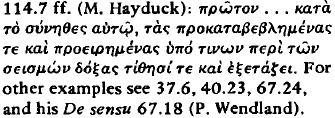 This meaning is not given clearly in LSJ.
This meaning is not given clearly in LSJ.
10 The phrase ![]()
 example given is one from Plutarch. However, this idiom is found at least as early as Polybius (Krebs, F., Die Priipositionen bei Polybius (Würzburg, 1882), p. 103), and
example given is one from Plutarch. However, this idiom is found at least as early as Polybius (Krebs, F., Die Priipositionen bei Polybius (Würzburg, 1882), p. 103), and  Google Scholar
Google Scholar
11 ![]() added by Thurot Thurot, Charles, ‘Alexandre d'Aphrodisias. Cornmentaire De Sensu et Sensibili’, Notices et Extraits des Manuscrits de la Bibliotbèque Nationale 25 (1875), 118, n. 15.Google Scholar
added by Thurot Thurot, Charles, ‘Alexandre d'Aphrodisias. Cornmentaire De Sensu et Sensibili’, Notices et Extraits des Manuscrits de la Bibliotbèque Nationale 25 (1875), 118, n. 15.Google Scholar
12 ![]() plausibly suggested by Wend-land.
plausibly suggested by Wend-land.
13 ![]()
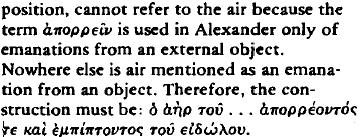
14 Usener's emendation ![]()
![]() is retained, the text would be stating that the quantity of air pushed forward by an idol depended not only on the distance covered by the idol but also on its size and shape. Since larger external objects emit larger idols, this notion is, of course, entirely reasonable. However, other sources do not mention it. Whichever text we prefer, the remaining part of this sentence cannot be literally true. The air pushed by an idol cannot be all the air
is retained, the text would be stating that the quantity of air pushed forward by an idol depended not only on the distance covered by the idol but also on its size and shape. Since larger external objects emit larger idols, this notion is, of course, entirely reasonable. However, other sources do not mention it. Whichever text we prefer, the remaining part of this sentence cannot be literally true. The air pushed by an idol cannot be all the air ![]() . It would have to be a column of air of the same frontal area as that of the idol. To what extent the atomists were aware of all these considerations is not known. For the singu- lar
. It would have to be a column of air of the same frontal area as that of the idol. To what extent the atomists were aware of all these considerations is not known. For the singu- lar ![]() see n. 15.
see n. 15.
15 The singular ![]()
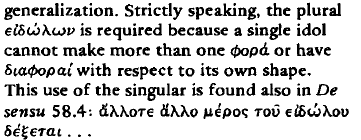
16 Since ![]()

17 For the singular ![]()
18 As becomes clear later in these passages, Alexander assumes that in the atomist doctrine the small parts of each successive idol emanating from an object and entering the pupil are somehow recombined in the eye to form a likeness of the external object. In order for such a recombination to be successful Alexander assumes that those parts of successive idols which (sc. parts) enter our pupils must correspond to successive contiguous parts of the external object. If we were to receive the same section of each successive idol-for instance, the upper left-hand corner of 1. house-obviously no truthful reconstruction of the likeness of the external object could occur. This last notion is referred to in the ![]() context indicates that Alexander is here holding against the atomist doctrine the possibility that those parts of successive idols which (sc. parts) enter our pupil will not necessarily be parts representing contiguous parts of the external object. For instance, when looking at a man, the pupil could from the first idol receive part of an eye, from the second a part of the big toe, from the third a small wart, and so on. In such a case the reconstructed likeness of the man would have all the parts, but in monstrous disarrangement. That this is the
context indicates that Alexander is here holding against the atomist doctrine the possibility that those parts of successive idols which (sc. parts) enter our pupil will not necessarily be parts representing contiguous parts of the external object. For instance, when looking at a man, the pupil could from the first idol receive part of an eye, from the second a part of the big toe, from the third a small wart, and so on. In such a case the reconstructed likeness of the man would have all the parts, but in monstrous disarrangement. That this is the 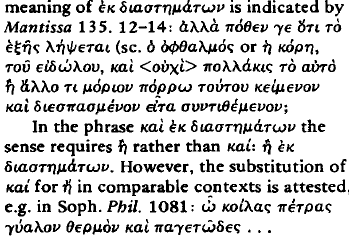
19 Alexander assumes here that while the representation of one external object is being built up in the eye by the addition of parts of successive idols from that object, parts of idols from other objects will be entering the eye as well ![]() . How will these other parts be kept from being integrated into the reconstruction of the idol of the first object? That this is the correct interpretation of the words of Alexander seems clear from Mantissa
. How will these other parts be kept from being integrated into the reconstruction of the idol of the first object? That this is the correct interpretation of the words of Alexander seems clear from Mantissa 
20 The Greek here is not quite clear. 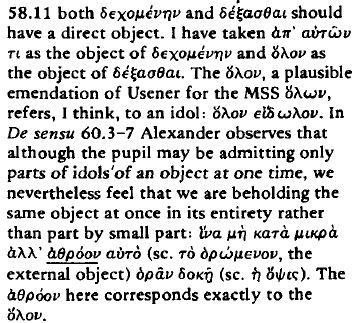
21 ![]()
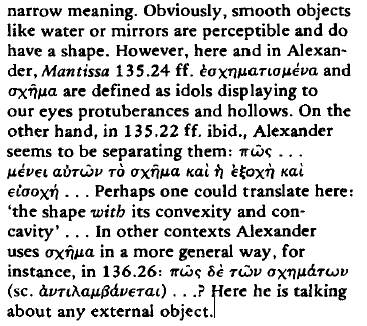
22 The Greek here appears to be, in less  external objects which, unlike mirrors, etc., do have protuberances.
external objects which, unlike mirrors, etc., do have protuberances.
23 Because of the corruption in the last part of the sentence the meaning is confused but is probably the same as in Alex ![]()
![]()
24 ![]() the reading of the MSS, does not seem to have any meaning appropriate to this context. Wendland suggests
the reading of the MSS, does not seem to have any meaning appropriate to this context. Wendland suggests ![]() from Mantissa 136.10.
from Mantissa 136.10.
25 This sentence assumes that if the idol acts as a stimulus it cannot be seen (so Mantissa 136.9–11).
26 This meaning of ![]()
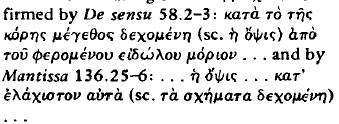
27 Alexander here seems to be assuming tacitly that if the idol is to enter the eye entire, the pupil must be larger than the idol. But, says Alexander, the pupil is not larger than the idol. Therefore the idol which, according to the atomists, does enter the pupil must be reconstructed in the eye out of the parts of successive idols which have entered ![]() If the entire idol is not seen at once, how can its shape and size be established, objects Alexander.
If the entire idol is not seen at once, how can its shape and size be established, objects Alexander.
28 With ![]()
![]()
29 ![]() because the meaning ‘what is next to the idol’ is not at all appropriate here. I take
because the meaning ‘what is next to the idol’ is not at all appropriate here. I take ![]() as a noun here. If the correct reproduction of the external object is to be reconstructed in the eye from the successive pupil-sized sections of the idols given off by the object, the sections must presumably enter the eye in the correct order (see n. 18 for more detail). In other words, if of idol A the pupil receives part 1, then of idol B it should receive and retain a part which in the external object is situated next to part 1 of idol A rather than another part 1 or a part not situated next to part 1 in the external object.
as a noun here. If the correct reproduction of the external object is to be reconstructed in the eye from the successive pupil-sized sections of the idols given off by the object, the sections must presumably enter the eye in the correct order (see n. 18 for more detail). In other words, if of idol A the pupil receives part 1, then of idol B it should receive and retain a part which in the external object is situated next to part 1 of idol A rather than another part 1 or a part not situated next to part 1 in the external object.
30 I have taken ![]()
![]()
31 Preserve in our perception, of course.
32 Alexander here seems to be picturing the representations of several external objects built up in the eye and each consisting of a mixture of parts derived from the idols of all these external objects. The result, of course, will be representations bearing no certain and perceptible relationship to the external objects.
33 The reference is to the parts of the idol entering the pupil.
34 According to the dictionaries the adverb ![]() is found only in Iliad 15.505 and in Pausanias 10.20.8. In both cases it refers to wading. In the Iliad the word is used in a sarcastic reproach. Ajax asks the Argives whether they expect to return home by wading if they now permit Hector to burn their ships. A sarcastic meaning is quite possible in our passage, too: Alexander may be conjuring up a man
is found only in Iliad 15.505 and in Pausanias 10.20.8. In both cases it refers to wading. In the Iliad the word is used in a sarcastic reproach. Ajax asks the Argives whether they expect to return home by wading if they now permit Hector to burn their ships. A sarcastic meaning is quite possible in our passage, too: Alexander may be conjuring up a man 
![]() (Heiberg, I. L. (ed.), Euclidis opera omnia, v. VII, ‘Opticorum recensio Theonis’ (Leipzig, 1895), 150.7–8 and 150.21–7.)Google Scholar
(Heiberg, I. L. (ed.), Euclidis opera omnia, v. VII, ‘Opticorum recensio Theonis’ (Leipzig, 1895), 150.7–8 and 150.21–7.)Google Scholar
35 See n. 21.
36 See n. 21.
37 The smooth walls must be thought here to be functioning, like water and mirrors, as reflecting surfaces. This follows from Alexander's interpretation (p. 141.305, In meteorologicorum … (Hayduck)) of Aristotle's reference to smooth surfaces: 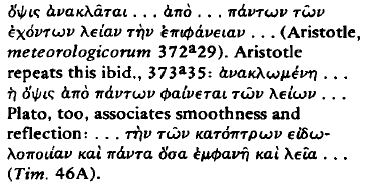
38 For ![]()
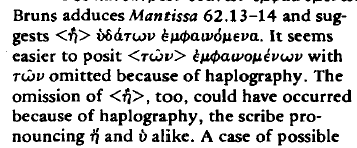 double haplography is reported by Renehan, Robert, Greek Textual Criticism (Cambridge, 1969), pp. 94–5.CrossRefGoogle Scholar
double haplography is reported by Renehan, Robert, Greek Textual Criticism (Cambridge, 1969), pp. 94–5.CrossRefGoogle Scholar
39 The beholder here must be looking in the mirror at his own image.
40 The interpretation of ![]()
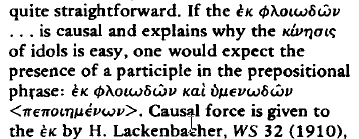 229. He does not, however, discuss the awkwardness of the Greek.
229. He does not, however, discuss the awkwardness of the Greek.
It would be rather more natural to ![]() agency. The Greek would then be stating that the idols are easily moved by things bark-like and membranaceous. These latter objects would have to be other idols. In other words, Alexander would be, saying that idols are so light that they are easily moved even by objects as light as other idols. (The idols are referred to as
agency. The Greek would then be stating that the idols are easily moved by things bark-like and membranaceous. These latter objects would have to be other idols. In other words, Alexander would be, saying that idols are so light that they are easily moved even by objects as light as other idols. (The idols are referred to as ![]() in a new fragment of Diogenes of Oenoanda, discovered and published by Smith, M. F., AJA 74 (1970) N. F. 1, Col. 3.2–3, 57. The connection between idols and bark is found in some MSS of, Plutarch, Non posse suaviter … 1106 A:
in a new fragment of Diogenes of Oenoanda, discovered and published by Smith, M. F., AJA 74 (1970) N. F. 1, Col. 3.2–3, 57. The connection between idols and bark is found in some MSS of, Plutarch, Non posse suaviter … 1106 A: ![]() simulacra to membranae in 4.31 and 4.51 and to cortex in 4.51).Google Scholar
simulacra to membranae in 4.31 and 4.51 and to cortex in 4.51).Google Scholar
The notion that one idol may be moved by another may be present in Lucretius 4.183–98, esp. 193–4. A. Barigazzi has argued strongly that the parvola causa … quae provehat … should refer not to ![]() in a physical object but rather to one idol's striking another from behind (PP 13 (1958), 269–73). It is essential to add to Barigazzi's argument that procul in Lucret. 4.194 must be taken with provehat atque propellat rather than with a tergo. This syntax was defended already by Susemihl, F. and Brieger, A., Philologus 29 (1870), 433.Google Scholar
in a physical object but rather to one idol's striking another from behind (PP 13 (1958), 269–73). It is essential to add to Barigazzi's argument that procul in Lucret. 4.194 must be taken with provehat atque propellat rather than with a tergo. This syntax was defended already by Susemihl, F. and Brieger, A., Philologus 29 (1870), 433.Google Scholar
41 ![]() could also mean: in the wind, when wind is blowing. However, idols would not necessarily be lost to the beholder if he were walking against the wind.
could also mean: in the wind, when wind is blowing. However, idols would not necessarily be lost to the beholder if he were walking against the wind.
42 From the context one would expect ![]()
43 For the MSS ![]()
 common in post-Classical Greek prose (Schmid, W., Der Atticismus in semen Hauptvertretern, IV (Stuttgart, 1896), pp. 97 and 623).Google Scholar
common in post-Classical Greek prose (Schmid, W., Der Atticismus in semen Hauptvertretern, IV (Stuttgart, 1896), pp. 97 and 623).Google Scholar
44 ![]() could also depend on
could also depend on ![]() The meaning remains the same.
The meaning remains the same.
45 After ![]()
![]()
46 ![]()
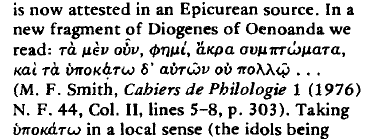 (Smith, M. F., Cahiers de Philologie 1 (1976) N. F. 44, Col. II, lines 5–8, p. 303). Taking
(Smith, M. F., Cahiers de Philologie 1 (1976) N. F. 44, Col. II, lines 5–8, p. 303). Taking ![]() in a local sense (the idols being finer … underneath) does not seem to make good sense because as far as we know the idols were of equal fineness throughout.Google Scholar
in a local sense (the idols being finer … underneath) does not seem to make good sense because as far as we know the idols were of equal fineness throughout.Google Scholar
47 Explanations not involving reduction in the size of the idols were attempted by Giussani, C., Lucreti, T.Cari De Return Natura, Excursus I to Book IV, p. 285 n. 1 (Turin, 1897)Google Scholar and Conche, M., Lucrèce et l'expérience (Paris, 1967), p. 102.Google Scholar
Bailey in his commentary on Lucretius thought that this problem was never faced by Epicurus (III, p. 1208). In this he was followed by Rist, J. M., Epicurus (Cambridge, 1972), p. 85.Google Scholar
48 Koenig, above, n. 3 and Woltjer, J., Lucretii philosophia cum fontibus comparata (Groningen, 1877), p. 87.Google Scholar
49 ’Epicurus, ![]() , TAPA 70 (1939), 417.
, TAPA 70 (1939), 417.
50 ‘La psicologia d'Epicuro e la teoria delle passioni’, Giornale critico della filosofia italiana 9 (1941), 12.Google Scholar
51 Plutarch gegen Kolotes, Acta Philosophica Fennica, Fasc. vii, 1955 (Helsingfors, 1955), pp. 165 f.Google Scholar
52 Epicuro, , Opere2 (Turin, 1973), p. 500.Google Scholar
53 ‘Sul nuovi frammenti di Diogene d';Enoanda’, Prometheus 3 (1977), 6.Google Scholar
54 Lucret. 5.1171, Cic. N. D. 1.49, Sext. Emp. Adv. math. 9.25 (= Us. 353).
55 Sext. Emp., above, n. 54: ![]()

56 See (24.43) in Arrighetti, above, n. 52 pp. 207 f. and 584 ff.
57 The Greek Atomists and Epicurus (Oxford, 1928), pp. 412–13.Google Scholar
58 Gnosis Theon, Symb. Osl. Supplet. XIX (Oslo, 1963), pp. 16–18.Google Scholar
59 Above, n. 49, 417–18.
60 Adv. math. 7.208 f. (= Us. 247). In this passage Sextus explains why a square tower appears round if seen from far away: 
![]() …
…
61 See discussion and references in Todd, R. B., ‘Lexicographical Notes on Alexander of Aphrodisias' Philosophical Terminology’, Glotta 52 (1974), 210 f.Google Scholar
62 The commentators' meaning of ![]()
![]() is also adopted for Epicurus by D. J. Furley, ‘Knowledge of Atoms and Void in Epicureanism’, Essays in Ancient Greek Philosophy, ed. John P. Anton with George L. Kustas (Albany, 1971), pp. 610 f.
is also adopted for Epicurus by D. J. Furley, ‘Knowledge of Atoms and Void in Epicureanism’, Essays in Ancient Greek Philosophy, ed. John P. Anton with George L. Kustas (Albany, 1971), pp. 610 f.
63 De Witt's theory has been supported with some changes by R. Westman, above, n. 51, 165–6. Westman differs from De Witt in not mentioning the passage of Sextus Empiricus and in suggesting that ![]()
![]() refers not to the process of reduction in size of the idol but rather to the end product, i.e.
refers not to the process of reduction in size of the idol but rather to the end product, i.e. ![]() is the reduced idol.
is the reduced idol.
64 Above, n. 57.
65 The need for gradual reduction was stated by Natorp, P., Forschungen zur Geschichte des Erkenntnisproblems im Altertum (Berlin, 1884), p. 226Google Scholar: ‘Dass es (sc. das Id) der Grösse nach mit der Entfernung abnimmt, ist klar’, and by Schiitte, H., Theorie der Sinnesempfindungen bei Lucrez (Danzig, 1888), p. 10: ‘dann können wir uns vorstellen dass alle dicht vor einander stehenden and bis an die Pupille unsers Auges reichenden Bilder beständig sich verkleinern, bis das erste Bild an der Pupille einen Durchmesser haben muss, der gleich ist demjenigen der Pupille selber.’Google Scholar
66 Burkert, W., ‘Air-Imprints or Eidola: Democritus' Aetiology of Vision’, ICS 2 (1977), 99–101.Google Scholar
67 Sens. 50 (= D-K, A 135, vol. 2, pp. 114.28 ff. or H. Diets, Dox. Graeci, p. 513). That  in this passage of Theophrastus referred ‘to the decreasing size of the image on its way to the eye’ was already asserted, although without argument, by Siegel, R. E., Galen on Sense Perception (Basel, 1970), p. 18 n. 22.Google Scholar
in this passage of Theophrastus referred ‘to the decreasing size of the image on its way to the eye’ was already asserted, although without argument, by Siegel, R. E., Galen on Sense Perception (Basel, 1970), p. 18 n. 22.Google Scholar
68 Democritea (Leningrad, 1970).Google Scholar
69 For the criticism of Theophrastus see above, n. 67, Sens. 36, 50, and 54. The other type of criticism may have begun with Cicero, who jokingly mentioned to Atticus the difficulties which the atomist ![]() might experience in trying to squeeze through the small windows of his house (Ad Att. 2.3.2). He may have been alluding here to the problem of the large idols and the small pupil. An even earlier objection to a similar theory of vision is attributed by Plutarch to Hieronymus of Rhodes (Quaest. Conviv. 1.8.3, 626 A-B). It is rather certain, however, that the doctrine attacked by Hieronymus could not have been that of any known atomist. Other objections are found in Galen, plac., pp. 615–16 (v. p. 618 Kühn) and p. 639 Mueller (v. p. 639 Kühn), in Plotinus, 4.5.3 and, possibly, 4.6.1, in St. Basil, Against Eunomius 3.6, in Macrobius, Sat. 7.14.11, in St. Augustine, Ep. 118.29 (P. L. 33, p. 446), and in Nemesius, De nat. hom., p. 180 Matthaei, who explicitly quotes from Galen.
might experience in trying to squeeze through the small windows of his house (Ad Att. 2.3.2). He may have been alluding here to the problem of the large idols and the small pupil. An even earlier objection to a similar theory of vision is attributed by Plutarch to Hieronymus of Rhodes (Quaest. Conviv. 1.8.3, 626 A-B). It is rather certain, however, that the doctrine attacked by Hieronymus could not have been that of any known atomist. Other objections are found in Galen, plac., pp. 615–16 (v. p. 618 Kühn) and p. 639 Mueller (v. p. 639 Kühn), in Plotinus, 4.5.3 and, possibly, 4.6.1, in St. Basil, Against Eunomius 3.6, in Macrobius, Sat. 7.14.11, in St. Augustine, Ep. 118.29 (P. L. 33, p. 446), and in Nemesius, De nat. hom., p. 180 Matthaei, who explicitly quotes from Galen.
70 Above, n. 69, 184–5. W. W. Jaeger argues that the source of Nemesius here was Galen (Nemesius von Emesa (Berlin, 1914), p. 32). Galen, however, when mentioning the inadequacy in this area of Aristotle, Epicurus, and some unnamed philosophers (above, n. 69, pp. 638–9) suggests nothing better. If he had had a theory of his own, one would expect him to mention it here.Google Scholar
17 It is very interesting to notice that the brilliant Giussani (above, n. 47), although ignorant of the passages in Alexander, offered a tentative atomist solution for the large-idol problem which is precisely that given by Alexander. Giussani, of course, saw its weak spot and thought that the required reduction of the large idol took place during its rebuilding in the eye. On this point he went beyond our evidence. It is relevant to the discussion on the reduction in size of idols to note that in Giussani's opinion the reduction of entire large idols to the size of the pupil was inconceivable in Epicurean doctrine (ibid.).
72 De sensu 60.3 ff.: although the eye receives only a piece of each idol, it nevertheless ![]()
![]() In this passage an object is said to be seen as soon as one idol has been reassembled. Mugler (above, n. 3, 24–5) uses the text of Alexander as support for the traditional explanation, but the context is against him.
In this passage an object is said to be seen as soon as one idol has been reassembled. Mugler (above, n. 3, 24–5) uses the text of Alexander as support for the traditional explanation, but the context is against him.
73 See, for instance, Bailey (above, n. 57, 410), who detects the hint in Ep. Hdt. 50: ![]()
![]() .
.
74 Essentially the same meaning is obtained if we keep the singular ![]() , the reading of all the manuscripts. On this reading we translate: ‘for this reason it is an idol which is
, the reading of all the manuscripts. On this reading we translate: ‘for this reason it is an idol which is ![]() and
and ![]() that presents us with a
that presents us with a ![]() (sc. of itself).’ The sequence of thought is less smooth; on the other hand the reading of the MSS is kept.
(sc. of itself).’ The sequence of thought is less smooth; on the other hand the reading of the MSS is kept.
75 For occurrences see the index in Arrigh.2, above, n. 52, 779 and Usener, H., Glossarium Epicureum (Rome, 1977), pp. 591–2.Google Scholar
76 This was suggested by Giussani, above, n. 71.
77 This objection applies also to De Wit's hypothesis, mentioned above, that ![]()
![]() referred to the to-scale reduction of the idols in their transit from the object to the pupil.
referred to the to-scale reduction of the idols in their transit from the object to the pupil.
78 Above, n. 61.
79 For instance, in De insomn. 459a24 ff. 
![]()

![]() (De mem. 450a 25 ff., Ross's text).
(De mem. 450a 25 ff., Ross's text).
80 Such impressions either in the eyes or in the mind could be referred to elsewhere in Epicurus by the ![]() in Ep. Hdt. 49.
in Ep. Hdt. 49.
81 C. Diano states of Epicurean perception: ‘identica alla percezione degli occhi è quella della mente’ ‘La psicologia d'Epicuro e la teoria delle passioni’, Giornale critico della filosofia italiana 20 (1939), 133.Google Scholar
82 As mentioned above, I have assumed throughout this paper that Alexander's knowledge of the atomists' doctrines attacked by him was indeed accurate. However, it is somewhat disturbing that neither, for instance, Theophrastus in his account of Democritus, nor Galen, when he demands how large Epicurean idols could enter the pupil (above, n. 69, 639 Mueller and Kühn), mentions the theory found in Alexander. Various answers are possible. Theophrastus may have omitted it in his brief account or found it unsatisfactory. Galen may have been ignorant of it or, also, found it an unsatisfactory answer for his problem. Alternatively, Alexander's theory may have arisen after the death of Epicurus and may not have found entry into the Epicurean orthodoxy. It may even have been excogitated after the death of Galen. However, I felt that it was worth while methodologically to take Alexander's assertions at face value in order to see what new light they could, on that assumption, shed on Epicurean philosophy.
83 Mugler, disregarding the context, wrongly renders ![]() here by ‘to be shortsighted’ (Dictionnaire historique de la terminologie optique des grecs (Paris, 1964), p. 264).Google Scholar
here by ‘to be shortsighted’ (Dictionnaire historique de la terminologie optique des grecs (Paris, 1964), p. 264).Google Scholar
84 Above, n. 34, p. 148.20–2.
85 Accounts are found in Plutarch, Epit. 4.14–15, Stobaeus, Ecl. 1. 52 (44), and Galen, Hist. Philos. 95; the first two are subsumed by H. Diels, Dox. Graeci under Aetius 4.14 (p. 405); the third is found ibid., pp. 636–7.
86 Dox. Graeci, p. 405.15–22.
87 For this meaning of ![]() + acc. see LSJ B III:
+ acc. see LSJ B III: ![]()
![]() , etc.
, etc.
88 The passage containing the stationary idols does not appear in De sensu. What conclusions can be drawn from this fact is uncertain.
89 The most famous of these expressions of subjectivity is ![]()
![]() (D.-K., v. 2, 68 A 49.8–9, p. 97). For a general account see Guthrie, W. K. C., A History of Greek Philosophy, II (Cambridge, 1965), pp. 454–65.Google Scholar
(D.-K., v. 2, 68 A 49.8–9, p. 97). For a general account see Guthrie, W. K. C., A History of Greek Philosophy, II (Cambridge, 1965), pp. 454–65.Google Scholar
90 Above, n. 5.
91 Above, n. 4.
- 6
- Cited by


